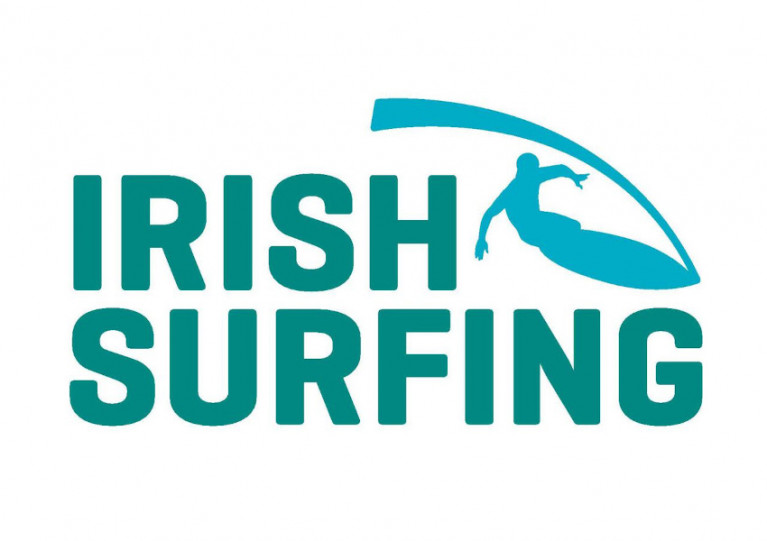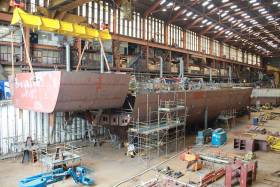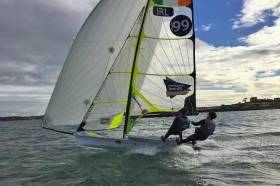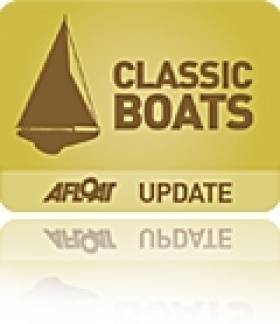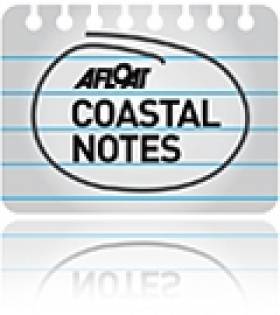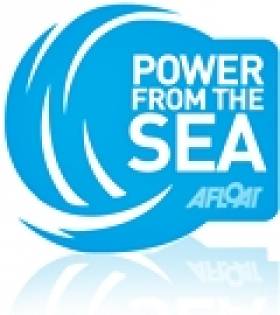Displaying items by tag: Crowdfunding
Irish Surfing Launches Crowdfunding Campaign For Live Scoring Display
Irish Surfing has launched a crowdfunding campaign to purchase a live scoring system for competitive events.
The national governing body for surfing in Ireland is already nearly a third of the way towards the €6,000 goal for the priority display system.
Junior and senior competitors, spectators and race officials alike would benefit from this effort to professionalise its delivery of events, Irish Surfing says.
All funds raised will be administered through Irish Surfing’s Sligo base with a view to purchasing and training staff with using the system over the coming months.
The Royal Irish Yacht Club’s Saskia Tidey and her Team GB sailing partner Charlotte Dobson have launched a crowdfunding campaign to support their efforts to qualify for the 49erFX class in next summer’s Olympic Games in Tokyo.
The pair, who finished seventh among a strong field of contender at the 49erFX Europeans last month, say they have reached a “hurdle” in their present fundraising efforts.
“The level of financial backing we have needed to maintain podium positions has now exceeded beyond what our campaign budget is capable of.”
But with additional backing, they say, “we absolutely believe we can complete and deliver the training programme we have planned to bring home a medal”.
Saskia and Charlotte have set a £5,000 of which they have raised nearly a quarter in less than a week.
For more on the pair’s campaign, see their GoFundMe page HERE.
Read the pair’s full appeal below:
We are Olympians Saskia Tidey & Charlotte Dobson. Team mates onboard our 49er FX Olympic class skiff dinghy representing Great Britain on the British Sailing team. We need your help!
After the Rio 2016 Olympic games concluded we left with fire in our bellies and our eyes and hearts set on the goal to medal at the Tokyo 2020 Olympic Games in Japan.
For three years we have battled on the International World Sailing circuit to bring home medal winning performances for Great Britain. It has been a honour to fly the flag and and a privilege to be under the pressure of striving for greatness.
Unfortunately we have reached a hurdle in our campaign which we are finding increasingly difficult to jump. The level of financial backing we have needed to maintain podium positions has now exceeded beyond what our campaign budget is capable of. With additional funds we absolutely believe we can complete and deliver the training programme we have planned to bring home a medal.
This summer we will represent Great Britain at the 2019 Olympic Test event in Japan. Please follow our journey and donate before August 2019 to help us reach the gold standard program we need to continue to succeed!
With Tokyo 2020 just around the corner we are seeking help and support from anyone would would like to join our journey and help us keep on the podium for Great Britain in 2020!
Sailing is a sport that can be overlooked and misunderstood but it is an exhilarating sport which is accessible to everyone and we would love to entice more viewers to enjoy it too!
Please help us on on our journey!
Follow our story on Instagram @gbr_44fx
Help Spread the word!
Charlotte & Saskia xox
A Plymouth businessman Connor Johnson reports North Devon Gazette has launched a critical campaign through crowdfunding to raise £400,000 by the end of May to seed the revitalisation of the Appledore shipyard which closed in March.
Mr Johnson says he has an investor company waiting in the wings and willing to put in £4 million if he can raise 10 per cent of the capital needed.
He has launched a gofundme online page and says those who invest a minimum of £100 will receive 100 shares in the new Appledore Shipyard Ltd company he has just created. There are also options to invest £500 or £1,000.
The director of Patriot Yachts International in Plymouth is convinced Appledore has a future as a shipyard and believes there are plenty of opportunities to win contracts in the civilian boat market.
For further reading click here on the yard that Afloat.ie adds built a quartet of OPV90's (P60 class) ordered by the Irish Government's Department of Defence and servce a career in the Naval Service.
The shipyard's final ship, L.E. George Bernard Shaw (P64) was last month named and commissioned into the Naval Service at a ceremony held on Waterford City quays.
A previous pair of the OPV80 (P50 class) were too completed for the Naval Service at the facility near Bideford albeit under different ownership.
Irish 49er Duo Launch Crowdfunding Campaign For Tokyo 2020 Ambitions
#49er - More than €5,000 is the cost of competition for Ryan Seaton and Seafra Guilfoyle as they prep for their first event as a duo in Mallorca this coming spring.
The new combination have joined with PledgeSports to crowdfund the necessary budget for a new 49er skiff plus flights, accommodation and ferries as they ready for their debut competition event in the Balearic Islands.
Ahead of that, they will be training with other Olympic hopeful teams and coaches in Cadiz and Mallorca in preparation for a season that builds on a tremendously successful 2016 for Irish high performance sailing.
As previously reported on Afloat.ie, last month double Olympian Seaton teamed up with 20-year-old Royal Cork prospect Guilfoyle, making his comeback from an injury that ruled him out of last summer’s Olympics, with ambitions to represent Ireland in the skiff class at Tokyo 2020.
But they will face strong competition for that spot, not least from Seaton’s former partner and fellow Belfast sailor Matt McGovern, with whom he finished in the top 10 in Rio, who is also currently looking for a new skiff partner.
More on the €5,350 Seaton and Guilfoyle are looking to raise can be found on the PledgeSports website HERE.
#NaomhÉanna - Afloat.ie previously reported that restoration of the former Aran Islands ferry Naomh Éanna required solid financial backing before a number of ambitious future plans for the boat could proceed.
Now campaigners for the historic vessel have turned to the internet to seek funding for the first step of their rejigged refurbishment plan – now starting with the proposed micro brewery.
Organisers believe that setting up the brewery first – with a funding target of €3,000 for the necessary equipment and licences – will provide the revenue stream needed to get further restoration works in motion, as well as "show investors and banks that we are actually doing something", as the project's IndieGoGo page explains.
It's hoped that the micro brewery will operate from the Naomh Éanna at its Grand Canal Dock berth – and tours of the ship and the proposed brewing facilities are among the perks available for contributors to the crowdfunding campaign, which has 55 days left to go as of Wednesday 20 May.
#Crowdfunding - Campaigning documentary maker Richie O'Donnell is turning to the public to help fund his latest film about Ireland's marine resources.
The filmmaker behind critically acclaimed documentary The Pipe, about the controversial Corrib Gas Pipeline, tells TheJournal.ie that his new project takes a much broader scope, specifically the fishing and petrochemical resources off Ireland's Atlantic coast.
With Atlantic, O'Donnell is attempting to "connect the dots" between Ireland's attitude to fishing and the State's management of offshore oil and gas.
To this end he has shot footage and interviews among West of Ireland coastal communities as well as much further afield in Norway and Newfoundland.
And his ambitious film has an appropriately ambitious funding target of €25,000 - the largest yet on Irish crowdfunding website Fundit.
"If we can do this and bring the film straight to the people who want to watch it," says O'Donnell, "then that could open up a massive opportunity.”
TheJournal.ie has much more on the story HERE.
#NewDesign - A new catamaran designed for servicing offshore drilling and energy platforms could help work crews get to where they're needed safety in some of the roughest seas.
Wired's Autopia blog reports on the SHC Wavedancer, a proposed catamaran with a submersible hull that could literally cut through and dissipate potentially dangerous waves - keeping the vessel stable enough in swells of up to 15 feet so that delicate operations, such as work on oil pipelines or wind turbines, can proceed without delay.
The new design is the work of veteran energy installation and construction consultant Dennis Knox, who is looking to crowdfunding to finance the first stages of the project.
Wired Autopia has more on the story HERE.


























